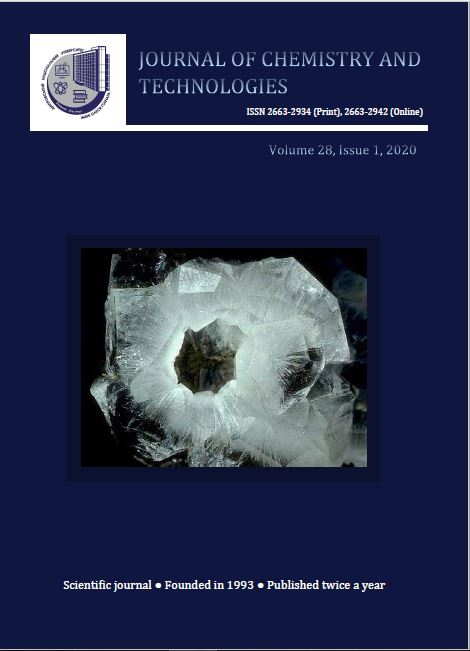DETERMINATION OF HEAT TRANSFER COEFFICIENTS DURING THE FLOW OF NON-NEWTONIAN FLUIDS IN PIPES AND CHANNELS OF CHEMICAL PROCESS EQUIPMENT
DOI:
https://doi.org/10.15421/082010Keywords:
non-Newtonian fluid, flow, heat transfer, pipe, channel, Nusselt numberAbstract
The problem of heat transfer of non-Newtonian fluids in the channels of chemical-technological equipment is considered. A mathematical model is proposed for determining heat transfer characteristics during the flow of Bingham fluids, generalized displaced fluids and power fluids in channels of different geometries. During the Bingham fluid flow, for the calculation of heat transfer coefficients, the convective temperature transfer equation is given in the approximation of the thermal boundary layer so that only the transverse derivative with respect to y is stored on the right side, and the x coordinate is assumed to be aligned along the tangent component of the fluid flow velocity. Nusselt numbers are determined by the derivatives of the tangent velocity on the walls of the channels and at the boundaries of the solid core. If the tangent of the fluid velocity on the wall has two components, then the velocity, the derivative of the Nusselt number, is determined through these components in accordance with the Pythagorean theorem. When a generalized shear fluid is used to calculate the Nusselt numbers, it must be taken into account that in a flat channel with longitudinal and longitudinal-transverse flows there are two heat transfer coefficients, and in a rectangular channel there are four heat transfer coefficients. The determination of the heat transfer coefficients of a power-law fluid is considered only for longitudinal flow in a flat channel and is carried out similarly to the calculation procedure for Bingham and generalized-shear fluids. The obtained expressions, when carrying out engineering calculations, allow us to calculate the corresponding heat transfer and heat transfer coefficients during the flow of non-Newtonian fluids in the channels and with the environment.References
Harlamov S. (2013) [Gidrodinamika i teploobmen: Novyie tendentsii i perspektivyi modelirovaniya vnutrennih techeniy]. LAP LAMBERT Academic Publishing. (in Russian).
Ulyev, L. M. (2016). [Laminar flow in coaxial conical channels]. Kharkiv. Ukraine: NTU "KhPI". (in Ukraine).
Cantelli, A. (2009). [Uniform Flow of Modified Bingham Fluids in Narrow Cross Sections]. Journal of Hydraulic Engineering. 135(8). 640-50.
Baptista A., Alves M.A., Coelho P.M. (2014) [Heat transfer in fully developed laminar flow of power law fluids]. Journal of Heat Transfer. 136(4). 1-8.
Golovanchikov, A. B., Shagarova, A. A. (2015). [Modeling the flow of a viscoplastic reaction mass in a screw reactor with a low viscosity wall layer]. Izvestiya vuzov. Khimiya i khimicheskaya tekhnologiya. 58 (12), 69-72.
Ponomareva, M. A. Filina, M. P., Yakutonok, V. A. (2016). [Circulating flow of high viscosity non-Newtonian fluid in a single-screw extruder channel]. Vestnik Tomskogo gosudarstvennogo universiteta. Matematika i mekhanika., 2 (40), 97-107.
Tovazhnyansky, L. L., Biletsky, E.V., Tolchinsky Yu. A. (2013) [Modeling of flows of non-Newtonian fluids in channels of basic geometry]. Kharkiv. Ukraine: NTU "KhPI". (in Ukraine).
Kolgruber, K. (2016). [Twin-screw, co-directed extruders. Basics, technology, application] Saint Petersburg. Russian Federation: Profession. (in Russian).
Ryabinin M. V., Trukhanov K. A. (2015). [The method of determining friction losses in a hydraulically smooth round pipe for pseudoplastic fluids]. Sovremennyye problemy nauki i obrazovaniya. 1(1). - http://www.science-education.ru. (in Russian).
Anandha, Rao M. (2014). Rheology of Fluid, Semisolid, and Solid Foods: Principles and Applications. New York, USA : Imprint: Springer (in English).
Perminov, A. V., . Lyubimova, T. P. (2014). [Stability of a stationary plane-parallel flow of a pseudoplastic fluid in a flat vertical layer]. Vychislitel'naya mekhanika sploshnykh sred. 7(3). 270 – 278.
Mitsoulis, E., Tsamopoulos, J., (2017). Numerical simulations of complex yield-stress fluid flows. Rheologica Acta 56. 231–258.
Frigaard, I. A., Paso, K., de Souza Mendes, P., (2017) Binghams model in the oil and gas industry. Rheologica Acta 56. 259–282.
Biletsky, E. Petrenko, E., Semeniuk, D. (2014). Theoretical aspects of non-newtonian fluids flow simulation in food technologies. Ukrainian Food Journal. 3(2), 271-280.
Biletsky, E. Petrenko, E., Semeniuk, D. (2016). Three-dimensional model of non-Newtonian fluid flow in the rectangular channel. Ukrainian Food Journal. 5(3), 550-560.
Petrenko, E., Biletsky, E., Semeniuk, D. (2019). Modeling of the viscoplastic flow of a bingam fluid with transverse circulation in a rectangular channel of a worm machine. Journal of Chemistry and Technologies. 27(2), 550-560.
Kirsanov, E. A., Matveenko V. N. (2016). [Non-Newtonian Current of Disperse, Polymer, and Liquid Crystal Systems] Moscow. Russian Federation: Technosphere. (in Russian).
Borzenko E., Ryltsev I., Frolov O. Shrager G. (2017) [Nonisothermal filling of a planar channel with a power-law fluid]. Journal of Physics: Conf. Series. 899. 1-6.
Saramito, P., Wachs A., (2017). [Progress in numerical simulation of yield stress fluid flows]. Rheologica Acta 56. 211–230.
Frank-Kamenetskii D.A. (2015) [Diffusion and Heat Exchange in Chemical Kinetics]. Princeton. USA : Princeton University Press. (in English).
Downloads
Published
Issue
Section
License
Copyright (c) 2020 Днипровский национальный университет имени Олеся Гончара

This work is licensed under a Creative Commons Attribution 4.0 International License.
- Authors reserve the right of attribution for the submitted manuscript, while transferring to the Journal the right to publish the article under the Creative Commons Attribution License. This license allows free distribution of the published work under the condition of proper attribution of the original authors and the initial publication source (i.e. the Journal)
- Authors have the right to enter into separate agreements for additional non-exclusive distribution of the work in the form it was published in the Journal (such as publishing the article on the institutional website or as a part of a monograph), provided the original publication in this Journal is properly referenced
- The Journal allows and encourages online publication of the manuscripts (such as on personal web pages), even when such a manuscript is still under editorial consideration, since it allows for a productive scientific discussion and better citation dynamics (see The Effect of Open Access).


